+ Open data
Open data
- Basic information
Basic information
| Entry | Database: PDB / ID: 6esb | |||||||||
|---|---|---|---|---|---|---|---|---|---|---|
| Title | BK polyomavirus + 20 mM GT1b oligosaccharide | |||||||||
 Components Components |
| |||||||||
 Keywords Keywords |  VIRUS / VIRUS /  Polyomavirus / Receptor / Polyomavirus / Receptor /  Complex / Complex /  Glycan Glycan | |||||||||
| Function / homology |  Function and homology information Function and homology informationcaveolin-mediated endocytosis of virus by host cell /  : / permeabilization of host organelle membrane involved in viral entry into host cell / symbiont entry into host cell via permeabilization of inner membrane / T=7 icosahedral viral capsid / viral penetration into host nucleus / : / permeabilization of host organelle membrane involved in viral entry into host cell / symbiont entry into host cell via permeabilization of inner membrane / T=7 icosahedral viral capsid / viral penetration into host nucleus /  viral capsid / viral capsid /  : / protein complex oligomerization / monoatomic ion channel activity ...caveolin-mediated endocytosis of virus by host cell / : / protein complex oligomerization / monoatomic ion channel activity ...caveolin-mediated endocytosis of virus by host cell /  : / permeabilization of host organelle membrane involved in viral entry into host cell / symbiont entry into host cell via permeabilization of inner membrane / T=7 icosahedral viral capsid / viral penetration into host nucleus / : / permeabilization of host organelle membrane involved in viral entry into host cell / symbiont entry into host cell via permeabilization of inner membrane / T=7 icosahedral viral capsid / viral penetration into host nucleus /  viral capsid / viral capsid /  : / protein complex oligomerization / monoatomic ion channel activity / membrane => GO:0016020 / host cell endoplasmic reticulum membrane / host cell nucleus / virion attachment to host cell / structural molecule activity / : / protein complex oligomerization / monoatomic ion channel activity / membrane => GO:0016020 / host cell endoplasmic reticulum membrane / host cell nucleus / virion attachment to host cell / structural molecule activity /  DNA binding DNA bindingSimilarity search - Function | |||||||||
| Biological species |   BK polyomavirus BK polyomavirus | |||||||||
| Method |  ELECTRON MICROSCOPY / ELECTRON MICROSCOPY /  single particle reconstruction / single particle reconstruction /  cryo EM / Resolution: 3.4 Å cryo EM / Resolution: 3.4 Å | |||||||||
 Authors Authors | Hurdiss, D.L. / Ranson, N.A. | |||||||||
| Funding support |  United Kingdom, 1items United Kingdom, 1items
| |||||||||
 Citation Citation |  Journal: Structure / Year: 2018 Journal: Structure / Year: 2018Title: The Structure of an Infectious Human Polyomavirus and Its Interactions with Cellular Receptors. Authors: Daniel L Hurdiss / Martin Frank / Joseph S Snowden / Andrew Macdonald / Neil A Ranson /   Abstract: BK polyomavirus (BKV) causes polyomavirus-associated nephropathy and hemorrhagic cystitis in immunosuppressed patients. These are diseases for which we currently have limited treatment options, but ...BK polyomavirus (BKV) causes polyomavirus-associated nephropathy and hemorrhagic cystitis in immunosuppressed patients. These are diseases for which we currently have limited treatment options, but potential therapies could include pre-transplant vaccination with a multivalent BKV vaccine or therapeutics which inhibit capsid assembly or block attachment and entry into target cells. A useful tool in such efforts would be a high-resolution structure of the infectious BKV virion and how this interacts with its full repertoire of cellular receptors. We present the 3.4-Å cryoelectron microscopy structure of native, infectious BKV in complex with the receptor fragment of GT1b ganglioside. We also present structural evidence that BKV can utilize glycosaminoglycans as attachment receptors. This work highlights features that underpin capsid stability and provides a platform for rational design and development of urgently needed pharmacological interventions for BKV-associated diseases. | |||||||||
| History |
|
- Structure visualization
Structure visualization
| Movie |
 Movie viewer Movie viewer |
|---|---|
| Structure viewer | Molecule:  Molmil Molmil Jmol/JSmol Jmol/JSmol |
- Downloads & links
Downloads & links
- Download
Download
| PDBx/mmCIF format |  6esb.cif.gz 6esb.cif.gz | 360.4 KB | Display |  PDBx/mmCIF format PDBx/mmCIF format |
|---|---|---|---|---|
| PDB format |  pdb6esb.ent.gz pdb6esb.ent.gz | 300.9 KB | Display |  PDB format PDB format |
| PDBx/mmJSON format |  6esb.json.gz 6esb.json.gz | Tree view |  PDBx/mmJSON format PDBx/mmJSON format | |
| Others |  Other downloads Other downloads |
-Validation report
| Arichive directory |  https://data.pdbj.org/pub/pdb/validation_reports/es/6esb https://data.pdbj.org/pub/pdb/validation_reports/es/6esb ftp://data.pdbj.org/pub/pdb/validation_reports/es/6esb ftp://data.pdbj.org/pub/pdb/validation_reports/es/6esb | HTTPS FTP |
|---|
-Related structure data
| Related structure data |  3944MC  3945C  3946C  4212C M: map data used to model this data C: citing same article ( |
|---|---|
| Similar structure data |
- Links
Links
- Assembly
Assembly
| Deposited unit | 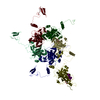
|
|---|---|
| 1 | x 60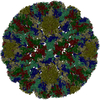
|
| 2 |
|
| 3 | x 5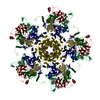
|
| 4 | x 6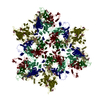
|
| 5 | 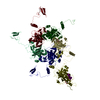
|
| Symmetry | Point symmetry: (Schoenflies symbol : I (icosahedral : I (icosahedral )) )) |
- Components
Components
| #1: Protein |  Mass: 40053.449 Da / Num. of mol.: 6 / Source method: isolated from a natural source / Source: (natural)   BK polyomavirus / Cell line: Vero / References: UniProt: Q65613, UniProt: P03088*PLUS BK polyomavirus / Cell line: Vero / References: UniProt: Q65613, UniProt: P03088*PLUS#2: Protein | | Mass: 38252.730 Da / Num. of mol.: 1 / Source method: isolated from a natural source / Source: (natural)   BK polyomavirus / Cell line: Vero / References: UniProt: P03094 BK polyomavirus / Cell line: Vero / References: UniProt: P03094#3: Polysaccharide | N-acetyl-alpha-neuraminic acid-(2-8)-N-acetyl-alpha-neuraminic acid Source method: isolated from a genetically manipulated source #4: Chemical | ChemComp-CA / |
|---|
-Experimental details
-Experiment
| Experiment | Method:  ELECTRON MICROSCOPY ELECTRON MICROSCOPY |
|---|---|
| EM experiment | Aggregation state: PARTICLE / 3D reconstruction method:  single particle reconstruction single particle reconstruction |
- Sample preparation
Sample preparation
| Component | Name: BK polyomavirus BK virus / Type: VIRUS / Entity ID: #1-#2 / Source: NATURAL BK virus / Type: VIRUS / Entity ID: #1-#2 / Source: NATURAL |
|---|---|
| Molecular weight | Experimental value: NO |
| Source (natural) | Organism:   Human polyomavirus 1 Human polyomavirus 1 |
| Details of virus | Empty: NO / Enveloped: NO / Isolate: STRAIN / Type: VIRION |
| Natural host | Organism: Homo sapiens |
| Virus shell | Name: Icosahedron / Diameter: 500 nm / Triangulation number (T number): 7 / Diameter: 500 nm / Triangulation number (T number): 7 |
| Buffer solution | pH: 7.5 |
| Specimen | Conc.: 0.25 mg/ml / Embedding applied: NO / Shadowing applied: NO / Staining applied : NO / Vitrification applied : NO / Vitrification applied : YES : YES |
Vitrification | Cryogen name: ETHANE |
- Electron microscopy imaging
Electron microscopy imaging
| Experimental equipment |  Model: Titan Krios / Image courtesy: FEI Company |
|---|---|
| Microscopy | Model: FEI TITAN KRIOS |
| Electron gun | Electron source : :  FIELD EMISSION GUN / Accelerating voltage: 300 kV / Illumination mode: FLOOD BEAM FIELD EMISSION GUN / Accelerating voltage: 300 kV / Illumination mode: FLOOD BEAM |
| Electron lens | Mode: BRIGHT FIELD Bright-field microscopy Bright-field microscopy |
| Image recording | Electron dose: 59 e/Å2 / Film or detector model: FEI FALCON III (4k x 4k) |
- Processing
Processing
CTF correction | Type: PHASE FLIPPING AND AMPLITUDE CORRECTION |
|---|---|
| Symmetry | Point symmetry : I (icosahedral : I (icosahedral ) ) |
3D reconstruction | Resolution: 3.4 Å / Resolution method: FSC 0.143 CUT-OFF / Num. of particles: 40334 / Symmetry type: POINT |
 Movie
Movie Controller
Controller



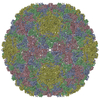

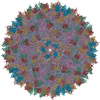



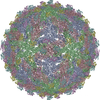

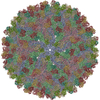
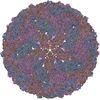
 PDBj
PDBj




